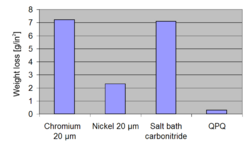Engineering:Quench polish quench
Quench polish quench (QPQ) is a specialized type of nitrocarburizing case hardening that increases corrosion resistance. It is sometimes known by the brand name of Tufftride, Tenifer or Melonite.[1] Three steps are involved: nitrocarburize ("quench"), polish, and post-oxidize ("quench").[2] This process is often used when two or more of the following properties are required in a workpiece:
- wear resistance
- corrosion resistance
- fatigue strength
Common applications of the process are for piston rods of shock absorbers, cylinders and rods for hydraulic systems, pumps, axles, spindles, firearm slides and barrels and valves.[3]
Process
The process starts with a standard salt bath nitrocarburizing cycle, which produces a layer of ε iron nitride.[4] Next, the workpiece is mechanically polished; typical polishing processes include vibratory finishing, lapping, and centerless grinding. Finally, the workpiece is re-immersed into the salt quench bath for 20 to 30 minutes, rinsed, and oil dipped. This last step optimizes the corrosion resistance by creating a layer of iron oxide about 3 to 4 micrometers thick.[5] It also gives the workpiece a black finish.[3][6]
Corrosion resistance
Field immersion
The chart on the right shows a comparison of corrosion resistance against other surface treatments, based on field immersion tests. Test conditions for the immersion test are full immersion in 3% sodium chloride plus 3 g /L of hydrogen peroxide for 24 hours.[citation needed]
Salt spray test
The chart on the right shows a comparison of the corrosion resistance of surface treated steel automotive steering columns based on the ASTM B117 salt spray test.[citation needed]
References
- ↑ "Melonite/QPQ". HEF Group (USA). 14 June 2012. http://www.hefusa.net/melonite_qpq.html.
- ↑ Davis, Joseph R., ed (2002). Surface Hardening of Steels: Understanding the Basics. ASM International. pp. 203–204. ISBN 9781615032501. https://books.google.com/books?id=eIfcHJtv_kcC&pg=PA203. Retrieved 16 February 2014.
- ↑ 3.0 3.1 Easterday, James R. (1996). "The Kolene QPQ(SM) Process". Kolene Corporation. http://www.finishing.com/kolene/qpq/.
- ↑ Liapina, T.; Leineweber, A. (June 2003). "Nitrogen redistribution in ε/γ′-iron nitride compound layers upon annealing". Scripta Materialia (Elsevier) 48 (12): 1643–1648. doi:10.1016/s1359-6462(03)00136-2.(Subscription content?)
- ↑ "Use Salt Bath Nitriding for Uniform & Consistent Layers". Northeast Coating. http://www.northeastcoating.com/products/salt-bath-nitriding.
- ↑ "QPQ Liquid Nitriding". Thermex Metal Treating Ltd. 2010. http://www.thermexmetal.com/qpq-liquid-nitriding.
External links
 |




